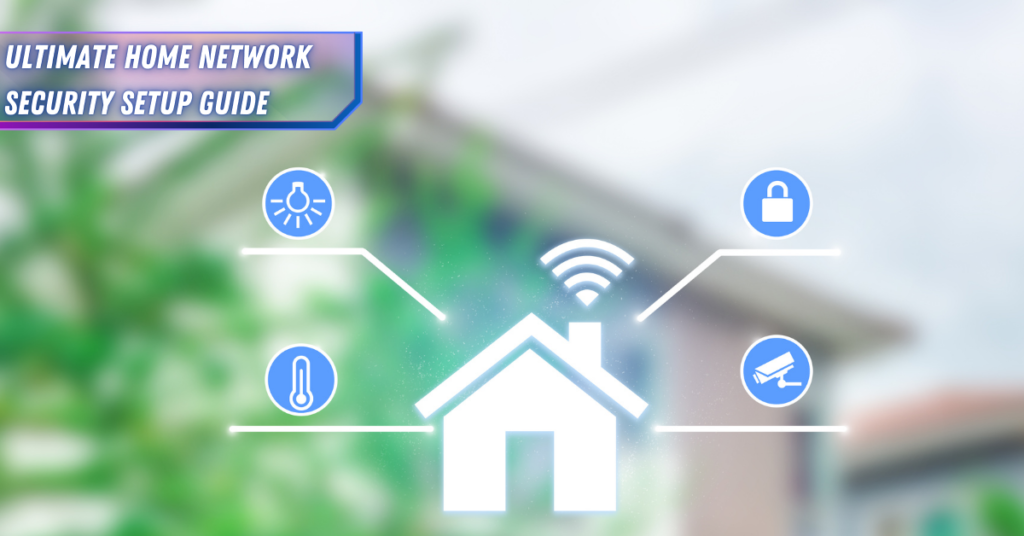Making our home networks secure seems tougher by the day. I understand this struggle all too well. Interestingly, the FBI noted an increase in cyber threats targeting our home spaces.
This blog post offers a Home Network Security Checklist to safeguard your Wi-Fi and gadgets. Together, let’s make it safe.
Key Takeaways
- Use strong passwords and change them often to keep your Wi-Fi and devices safe from hackers.
- Update your device’s software and firmware regularly to fix security holes.
- Enable multi-factor authentication (MFA) for an extra layer of security on your accounts.
- Use firewalls on all devices to block bad traffic.
- Consider using a VPN for more secure internet use, especially on public Wi-Fi.
Importance of Home Network Security
Securing my home network is not just important; it’s necessary. With the rise of cyber threats, I learned that unprotected networks are like open doors for hackers. They can easily steal personal information, financial data, and even take control of devices connected to the network.
After implementing full disk encryption on my devices, following NSA best practices, and setting up comprehensive firewall protection, I saw a huge improvement in my network security.
Home network security is our first line of defense against cyber threats.
I now regularly update software and hardware to guard against vulnerabilities. It’s clear to me that without these steps, my sensitive data and those of anyone else on my network could be exposed or stolen by malicious actors.
The importance of securing access points cannot be overstated as it directly impacts the risk of unauthorized access and potential identity theft.
Let’s look at key vulnerabilities next.
Key Vulnerabilities in Home Networks
Unsecured WiFi networks and unsecured smart home devices are key vulnerabilities in home networks. Such vulnerabilities can leave your network open to potential cyber threats.
Unsecured WiFi networks
I found out the hard way that unsecured Wi-Fi networks are a big no-no. My own Wi-Fi once had a weak password. Hackers easily got in and snooped around. This taught me an important lesson.
Now, I always secure my home Wi-Fi network with strong passwords and change them regularly.
Securing my home Wi-Fi also means keeping the router’s firmware up to date. I learned that updates often fix security holes. So, I check for updates monthly and install them right away.
This step is crucial for keeping hackers out of my network and protecting my personal data.
Unsecured smart home devices
Smart home devices like cameras and thermostats make life easier. But, they can also open doors for hackers if not secured. My camera once got hacked because I used a weak password.
It was scary. I learned to always change default passwords and keep my devices’ software up to date. This helps protect against cyber attacks.
I also found out that enabling firewalls on smart devices adds another layer of security. After making these changes, my network felt safer. My personal data, especially on connected devices, seemed more secure from unauthorized access and potential breaches.

Essential Security Practices
Implement strong passwords and use a password manager. Enable multi-factor authentication (MFA) for added security. Regularly update software and firmware to protect against vulnerabilities.
Use strong passwords and a password manager
I ensure my passwords are strong by using a mix of upper- and lower-case letters, numbers, and symbols. I also make sure to avoid reusing the same password across multiple accounts.
A reliable password manager helps me create and securely store complex passwords for different online accounts. It saves me the hassle of remembering numerous strong passwords for all my logins while keeping them secure from cyber threats.
Implementing multi-factor authentication (MFA) adds an extra layer of security to my accounts, reducing the risk of unauthorized access even if someone gains access to one of my strong passwords.
Regularly updating software and firmware on all devices further enhances my defense against potential vulnerabilities and cyber attacks.
Implement multi-factor authentication (MFA)
Multi-factor authentication (MFA) adds an extra layer of security to your devices and online accounts. It requires two or more methods for verifying a user’s identity, making it harder for unauthorized individuals to access your sensitive information.
MFA commonly involves something you know, such as a password, plus something you have, like a smartphone that receives a verification code.
For instance, when I log into my email with MFA enabled, after entering my password, I receive a temporary code on my phone. This means even if someone obtains my password, they still can’t access my account without the additional verification from my phone.
By implementing MFA across various accounts and devices at home, you significantly reduce the risk of unauthorized access to your personal data and secure your digital presence.
This increased security can prevent cybercriminals from gaining access to important information like financial details or personal identification numbers should they obtain usernames and passwords through breaches or phishing attacks.
Therefore, incorporating multi-factor authentication (MFA) helps protect against potential cybersecurity threats targeting home networks and connected devices.
Regularly update software and firmware
I always make sure to regularly update the software and firmware on all my devices. This is crucial because these updates often include important security patches that can protect my devices from potential threats.
Hackers are constantly looking for vulnerabilities in software and firmware, so staying up to date with the latest updates helps me stay one step ahead of potential cyber threats.
Ensuring that I regularly update my software and firmware also helps to minimize vulnerabilities that could be exploited by cybercriminals. By adopting the most recent security measures through regular updates, I’m able to detect and block any malicious activity, enhancing the overall security of my home network.
Up-to-date Antivirus
Maintaining current antivirus software is a critical first line of defense for your home network security. A robust antivirus solution acts as a vigilant guardian, automatically scanning, identifying, and eliminating various forms of malware, including viruses, ransomware, trojans, and worms.
While most modern antivirus programs are user-friendly and simple to set up, their effectiveness relies heavily on regular updates. Enable automatic updates for both the software and virus definitions to ensure protection against newly emerging threats. Think of it like getting regular vaccinations – you need the latest versions to guard against new variants.
However, it’s important to understand that antivirus software isn’t a complete security solution. While effective against known threats, it may not catch sophisticated attacks like zero-day exploits or polymorphic viruses that can change their code to evade detection. This makes antivirus software just one component of a comprehensive security strategy.
Advanced Security Strategies
Implement network segmentation, use Virtual Private Networks (VPNs), and enable firewalls on all devices. For more detailed information, check out the full article.
Network segmentation
Network segmentation is a crucial security strategy for your home network. By dividing your network into separate smaller subnetworks, you create additional layers of protection against potential threats.
This reduces the impact of an attack by limiting its reach, making it easier to contain and mitigate any security breaches. Properly segmenting your network also allows you to control which devices can communicate with each other, adding an extra level of defense against unauthorized access.
I recommend implementing network segmentation through the use of VLANs (Virtual Local Area Networks) or separate physical networks for different types of devices on your home network.
For instance, you can isolate smart home devices from laptops and smartphones by placing them on different segments. This limits the ability of potential intruders to move laterally across your entire network if one segment becomes compromised.
Ultimately, it’s an effective way to enhance the overall security posture of your home network while keeping connected devices safe from cyber threats.
Use of Virtual Private Networks (VPN)
Implementing a Virtual Private Network (VPN) is essential for securing your home network. A VPN encrypts your internet connection, safeguarding your data from potential threats and ensuring privacy.
It creates a secure tunnel for transmitting information, protecting it from prying eyes.
The use of a VPN also allows you to access the internet securely while on public Wi-Fi networks, shielding your sensitive information from cybercriminals. With an increasing number of online security threats, using a VPN adds an extra layer of protection to keep your network and personal data secure against potential attacks or breaches.
Enable firewalls on all devices
I ensure to enable firewalls on all my devices, including laptops, tablets, and mobile phones. This acts as a protective shield against malicious traffic trying to enter the network and alerts me about any potentially harmful activities.
It is essential to regularly update the firewall software for better protection against new vulnerabilities.
By implementing firewalls on every device in my home network, I create an added layer of security that helps safeguard sensitive information from potential cyber threats.
Conclusion
Securing your home network is crucial to protecting your devices and personal information. By implementing strong passwords, enabling firewalls, and regular software updates, you can significantly reduce the risk of cyber threats.
It’s important to take proactive measures such as setting up a separate guest network and using a password manager for added security. With these essential practices in place, you can create a robust defense against potential vulnerabilities and unauthorized access.
Start securing your network today to safeguard your digital world!
FAQs
1. What is the first step to secure my home network?
The first step in securing your home network involves updating your operating systems and applications, including security software such as antivirus software. Ensure automatic updates are turned on for all devices connected to your network.
2. How can I protect my wireless network from vulnerabilities?
To safeguard against vulnerabilities, use robust security measures like Wi-Fi Protected Access 3 (WPA3) for your wireless network. Change default settings of your router and keep it up-to-date with the latest firmware to minimize known vulnerabilities.
3. Is there a way to monitor who has access to my home network?
Yes, you can track IP addresses of devices on your network through router’s settings or dedicated apps. This includes mobile devices, IoT devices, and other wireless gadgets that may pose potential entry points for hackers.
4. How do password managers help in enhancing home network security?
Using a password manager helps maintain strong passwords across multiple platforms without needing to remember them all – this reduces vulnerability while increasing password strength.
5. Can setting up a guest network improve the security of my home WiFi?
Absolutely! Setting up a separate guest network provides restricted internet access for visitors which prevents unwanted access to sensitive data transmitted over the main household wifi connection.
6. Are there any specific precautions needed when dealing with financial information online at home?
Always ensure you’re using secure protocols (like HTTPS), especially when transmitting sensitive information such as social security numbers or financial details online at home.



